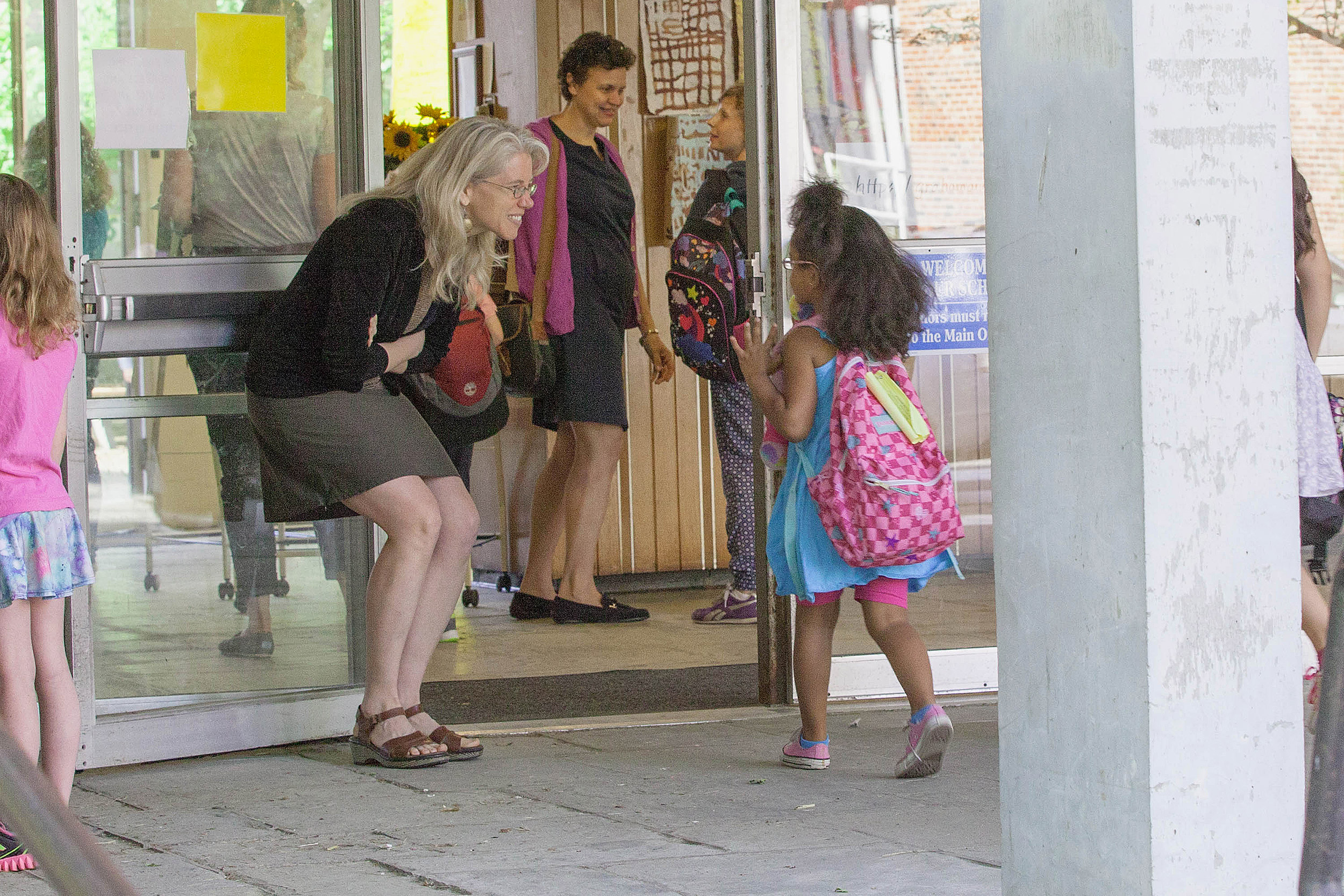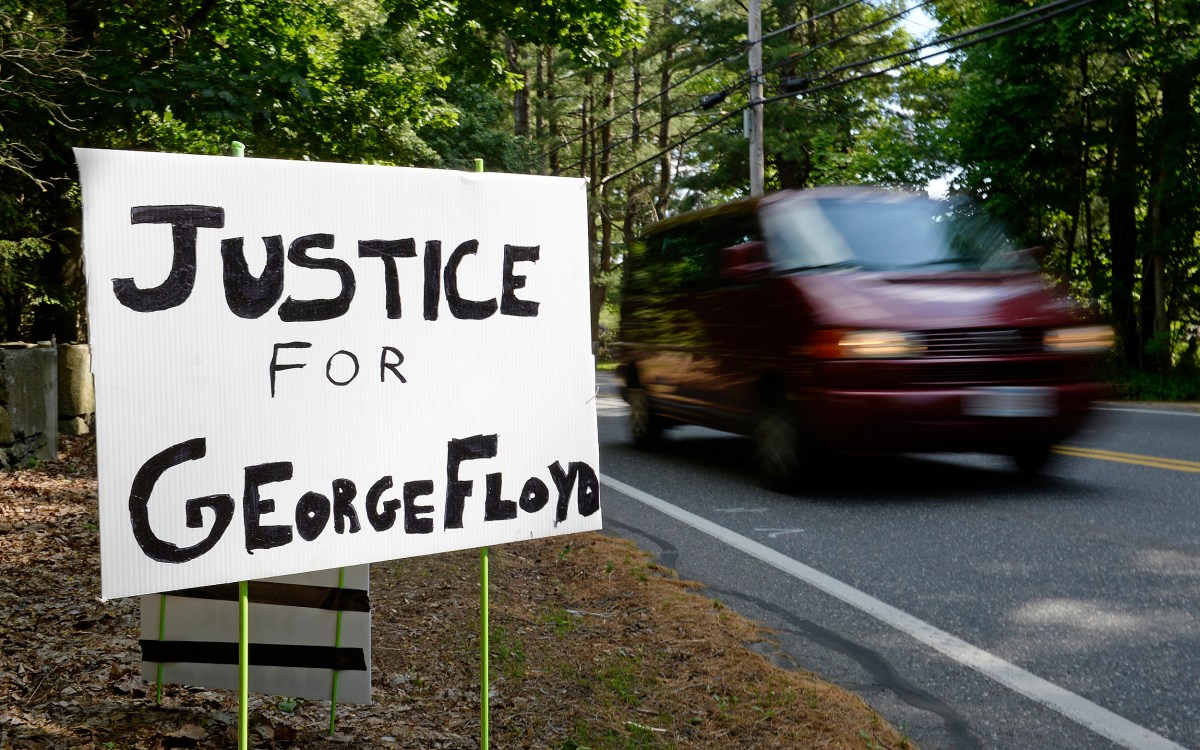
“If school leaders do nothing to address racism in schools, that’d be equivalent to continuing oppression,” said Tracey Benson, Ed.L.D. ’16.
Photo by Stephanie Zollshan/Berkshire Eagle
Helping teachers and principals confront their own racism
New book raises awareness of unconscious bias, and its effect on students of color
When Sarah Fiarman and Tracey Benson met in 2014 as class instructors at the Graduate School of Education (GSE), they bonded over their common experience as former school principals and their shared desire to battle racism in schools. Fiarman, Ed.D. ’09, and Benson, Ed.L.D. ’16, co-wrote the book “Unconscious Bias in Schools: A Developmental Approach to Exploring Race and Racism,” drawing on their experiences as principals in Massachusetts public schools. They were scheduled to discuss their new work at the Ed School in late April, but the event was canceled due to the pandemic. The Gazette interviewed the authors via Zoom to talk about the project and the need for educators and school leaders to start conversations about race and address racism in schools.
Q&A
Sarah Fiarman and Tracey Benson
GAZETTE: How widespread was racism in the schools you worked in as teachers or principals?
BENSON: I saw it all the time. It happens all day, every day. It happens in hallways, in classrooms, and throughout the system. Some of the most vivid examples I have seen took place when I would do classroom observations. We look at students’ race and gender and see how much they participate and how much they’re redirected. If it’s a multiracial classroom and if there are more white males, there is a preference for white males to participate. One particular example happened when I was observing a math class, and I noticed that the teacher was facing in a direction that actually cut off the Black and brown students from her peripheral vision, unintentionally and unknowingly. When I brought it to the teacher’s attention, she was shocked and changed her behavior, but she was actually selecting white males and females more than Black and brown students to participate in the classroom. It happens also with redirecting students. Black and brown students tend to be redirected for the same behaviors that white students aren’t redirected for; they’re policed more in the classroom, in the hallways, or at recess. These manifestations happen every day. They are below the conscious level, but it’s something that definitely affects the racial climate of the school building.
FIARMAN: The thing that I’ve had to learn is that even those of us — including myself — with all the best intentions can still be unconsciously lowering our standards for Black students or being more judgmental of Black or brown parents. There’s unconscious racial bias in ways both big and small in all the schools I’ve worked in, examples that taken individually might seem like minor problems, but taken collectively might have caused an enormous amount of harm to our Black and brown students.
There are also all sorts of innocuous things, such as when we as educators are reviewing and interpreting data about students, because the way we do both show our biases. For example, when Black students are not reading at grade level, too often we would view that data with an unintentional or unacknowledged sense of resignation. Too often as both a teacher and a principal, I focused on remediation as the solution, as if there was something wrong with our students instead of seeing that data as a reflection of something that we needed to correct in our fundamental practice.
I also had a very distinct wake-up call when I was teaching graduate students. I was concerned that a few Black students were having side conversations while I was talking, and I shared my concern with Tracey. He said he was pretty certain that there were white students in my class doing the same thing. I went through this whole process of feeling both defensive and offended that Tracey would have suggested that I was treating students differently based on race. But I went back to my classroom and noticed that Tracey was right; there were white students having side conversations and I had viewed that behavior without concern, whereas I viewed the same exact behavior by Black students with concern and with a desire to follow up with consequences.

When co-writing “Unconscious Bias in Schools,” Sarah Fiarman, Ed.D. ’09, (pictured) drew on her experience as a school principal.
Photo by Erica Modugno
GAZETTE: What was your motivation in writing this book?
More like this
FIARMAN: I was confident that I cared about my students, that I was deeply committed to equitable outcomes for all of them and to the academic success of my Black and brown students. But I saw evidence that I was, as Tracey said, favoring white students and viewing Black and brown students as more suspect and less capable. And when I saw that evidence in myself, I felt enormous urgency to get the word out to school leaders who are leading teachers who look like me and who I imagine care about kids and want to ensure more equitable outcomes, but might be causing harm because of the unexamined unconscious biases that are influencing our behavior every day. I feel a personal responsibility to share my part of the story. I hope that white teachers will see themselves in that and leaders will see their teachers in my example and come up with strategies to support and intervene.
BENSON: For me, it came from an immense frustration. As a Black student who attended a predominately white school, I experienced very intense, overt racism and also unintentional racism from teachers, from being placed in classes that were not the advanced classes even though I was smart. Nor were any of my Black counterparts seen as smart.
From a very young age, I understood what racism was and how it affected me, even though I didn’t have the language. As I worked my way up from elementary, middle school, high school, to college, I continued to experience intense racism from my instructors. When I got the opportunity to become a principal, I saw the same behaviors of my white teachers toward Black and brown students, and I actually made changes for students of color, but never directly addressing racism. The reason I wrote the book is because I had the experiences of a student who had dealt with racism, but also, as a principal, I wanted to help principals and district leaders talk directly about the impact of racism and name it as it should be.
GAZETTE: What challenges do school leaders face to start conversations about race in schools, and what can they do to overcome them?
BENSON: The biggest issue we have to deal with is the entitlement to racial comfort, especially with white teachers, principals, professors, and white folks at every level. White folks have a very low threshold for racial discomfort. To really dive into the complexity of racism we get a lot of pushback, because white folks are uncomfortable talking about race because they simply don’t have the experience. We need to start at a very low level because if we push too hard, they get uneasy and there’s a lot of resistance. White racial comfort, coupled with white racial arrogance, is something that Robin DiAngelo talks about in her book “White Fragility.” Many white folks, especially after the George Floyd protests and the nationwide reckoning around racism, feel they need to do something, but they don’t understand they have very low racial literacy. Some people rush to make a statement on their website or their social media page, or might tear down a monument, but those are very superficial interventions; the real work is to understand the depth of racism and how it affects both society in general and people of color. We have to fight against the propensity for white folks to want to do something now, and step back into racial literacy. We have to approach this in a way that we’re all on a racial learning continuum, and that there are folks out there who aren’t knowledgeable enough about how racism affects them and how they promote it, even inadvertently.
FIARMAN: Some of the challenges that spurred us to write this book took place when we worked with graduate students who were aspiring principals. Many students had a deep desire to practice antiracism in their school leadership, and they felt stymied either because of their own discomfort or their fear of blowback from white teachers who are typically uncomfortable with conversations about race. For us, the way to overcome these challenges is to stop thinking about racism as an issue of personal character, which immediately gets people defensive and shuts conversations down quickly, and instead, to think about this as an unconscious process that we’re all involved in, where we all absorb racism. It’s really about helping build skills for leaders to create the conditions for people to be able to name race at the school in mixed-race settings and understand racial biases and how they are disconnected from character and intent. We want to help school leaders build skills around understanding racism the same way educators learn skills around social and emotional learning or around literacy.
GAZETTE: What is the best approach to start conversations about race in schools? And what are the consequences of doing nothing?
FIARMAN: I think the most important way to start is to recognize that this is a lifelong work, and it’s not technical work; it’s work that is really adaptive. White leaders in particular need to adopt a real stance of racial humility to understand that we are usually the biggest barrier to our own progress. The more we can understand that we don’t know what we don’t know, the more we will be able to help ourselves achieve our intentions of being antiracist leaders.
The consequence of doing nothing is that we perpetuate a system that is systematically denying Black and brown students access to a quality education and a fully realized life. We’d also be teaching white students to hold the very same biases that are currently holding their Black and brown peers back. In other words, we’re reinforcing the structures that will ensure that Black and brown students and adults continue to be treated as less than fully human. This is fundamentally a moral issue, for all of us and for white people in particular. Every day that I am complacent about the fact that my Black and brown neighbors and fellow community members are being denied their rights while I’m granted mine is a day when I am not living in full moral integrity.
BENSON: The best way to start the conversation about race and racism in schools is to increase racial competency. Folks often get off track when they have a conversation with no aim and target; they will hire a consultant who’s usually Black or brown to talk to the staff, assuming that a talk will change behavior. That’s simply not true. School leaders need to reach out for support to increase racial competency; they can work with a consultant to decide what they’re doing and why they’re doing it and then move forward with that. That should be the primary goal. There’s such a want to be seen as anti-racist, and this is a big problem because we want to do something to say we’re doing something.
If school leaders do nothing to address racism in schools, that’d be equivalent to continuing oppression. This is something that we’ve been doing, for example, when we accept that Black and brown kids can’t achieve as well as white kids, which is a fallacy. And yet we’ve created as part of our collective consciousness that this is normal. We’ve even accepted terms such as the “school-to-prison pipeline” or the “achievement gap” as if it’s normal. Just because your skin color is brown doesn’t mean you’re less capable or competent. Now that we’ve come to the realization that police brutality is rooted in historical and structural racism, which means that if the color of your skin is Black or brown you’re more likely to be stopped and brutalized by police officers. We need to transfer that same thought to schools. There is intense racism within the school walls, from kindergarten all the way through college and graduate school. The outcomes that Black and brown students experience is specifically linked to historical and structural racism in our everyday lives. Once we can link it to that, then we can begin to solve the issue.
GAZETTE: What impact do you hope your book may have at this moment of national reckoning on racial injustice?
FIARMAN: I feel really heartened that there is so much interest from so many educators to understand that part of their job is to understand racism and address racism in their schools. I’m predominantly talking about white teachers because I think most teachers of color understand racism at a fundamental level.
Our book is not a how-to book with a set of steps that people need to follow. We deliberately wanted to lay out the bigger adaptive challenges that people need to grapple with to fight racism in school. My hope is that school leaders will pick up some new tools to frame this issue as a developmental process, not a process of blame, and use the concept of “unconscious bias” as an entry point for teachers who too often have shut down in conversations about race.
BENSON: I wrote my first case study back in 2015 when Michael Brown was killed in Ferguson, and I’ve been writing case studies about police brutality for quite some time. Folks have written iterations of our book over the course of the past 40 years by different titles. We actually are not saying anything new. But at this moment of racial awakening, our book provides tools for teachers and school leaders around the world to do their part in the fight against racism. My hope is that folks can take one or two strategies and implement them in the classroom, because that could actually change the outcomes for Black and brown students.
GAZETTE: Finally, what would you like teachers and school principals, administrators, and also parents to take away from your book?
BENSON: I want people to understand that racism is real, and that the disparate outcomes in student achievement, attendance, and behavior are linked to the vestiges of racism in schools. I want folks to recognize that racism affects us all and that we all, white, Black, brown people, have a role to play in antiracism. That should be the big takeaway from our book.
FIARMAN: I would like white leaders to accept that as white people we are going to make mistakes because we’ve been so indoctrinated in unconscious racial bias, racism, and white supremacy. But we have to make a choice. We need to decide whether we’re going to allow our Black and brown students and staff to bear the consequences of the racism that exists in our school communities or whether we are willing to humbly learn to do this work and make mistakes in the process. Because if we’re committed to fighting racism in our schools, we need to be ready to make those mistakes and see each other as learners and support each other in order to address racism. But fundamentally we need to be unwilling to continue with the status quo and realize that our silence as white leaders is basically complicity in our Black and brown students bearing the brunt of racism every day.
This interview has been edited and condensed for length and clarity.







